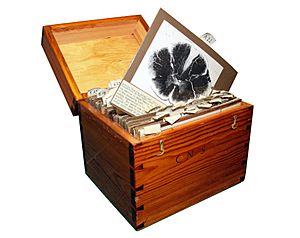Wilfrid Le Gros Clark facts for kids
Quick facts for kids
Wilfrid Le Gros Clark
|
|
|---|---|
| Born |
Wilfrid Edward Le Gros Clark
5 June 1895 |
| Died | 28 June 1971 (aged 76) |
| Awards | Fellow of the Royal Society Royal Medal (1961) Karl Spencer Lashley Award (1971) |
| Scientific career | |
| Institutions | St Thomas' Hospital University of Oxford Royal Army Medical Corps University College London |
Sir Wilfrid Edward Le Gros Clark (born June 5, 1895 – died June 28, 1971) was an important British scientist. He studied the human body as an anatomist and was also a surgeon. He also studied primates (like monkeys and apes) and early humans.
He is best known for his work on human evolution, which is how humans have changed over a very long time. He was a special professor of anatomy at the University of Oxford.
Contents
Early Life and Education
Wilfrid Le Gros Clark went to school at Blundell's School. After that, he became a medical student. He studied at the St Thomas' Hospital Medical School in Lambeth, London.
Wilfrid's Career Journey
After finishing his medical studies, Wilfrid Le Gros Clark joined the Royal Army Medical Corps. This was during World War I. He worked as a medical officer in France in 1918. He got sick with diphtheria and had to return to England. After recovering, he continued to serve as a medical officer in France for the rest of the war.

After the war, he worked in the Anatomy Department at St Thomas' Hospital Medical School. Later, he became the main medical officer for the government in Sarawak. Sarawak is a state in Malaysia, on the island of Borneo.
He then became a professor of anatomy at different medical schools. These included St Bartholomew's Hospital Medical School and St Thomas' Hospital Medical School. In 1934, he was invited to become the Dr. Lee's Professor of Anatomy at the University of Oxford. This was a very important job, making him the head of the Anatomy Department there.
The next year, he was chosen to be a Fellow of the Royal Society. This is a big honor for scientists in the UK. From 1938 to 1945, he also edited the Journal of Anatomy.
Solving the Piltdown Man Mystery
One of Le Gros Clark's most famous achievements happened in 1953. He worked with two other scientists, Joseph Weiner and Kenneth Oakley. They proved that the "Piltdown Man" was a fake.
The Piltdown Man was thought to be a very old human ancestor. It was a skull and jawbone found in England. But Le Gros Clark and his team showed that it was actually a modern human skull combined with an ape's jaw. This was a huge discovery in the study of human evolution.
Awards and Recognition
In 1960, Wilfrid Le Gros Clark was chosen to be part of the American Philosophical Society. This is a very old and respected group of thinkers.
He received the Royal Medal from the Royal Society in 1961. This is a very important award for scientific work. He also gave a special talk called the Ferrier Lecture in 1956. From 1951 to 1953, he was the President of the Anatomical Society of Great Britain and Ireland.
Le Gros Clark wrote many scientific papers about human evolution and palaeontology. Palaeontology is the study of fossils to learn about ancient life. He also wrote a book about his own life. His papers are kept at the Bodleian Library at Oxford University.

